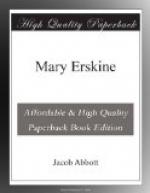The holes in the bottom of the dipper made it an excellent watering-pot, provided the garden to be watered was not too far from the brook: for the shower would always begin to fall the instant the dipper was lifted out of the water.
[Illustration: MARY BELL AT THE BROOK.]
After watering her garden again and again, Mary Bell concluded on the whole not to wait for her potatoes to grow, but dug them up and began to wash them in the brook, to make them ready for the roasting. Her little feet sank into the sand at the margin of the water while she held the potatoes in the stream, one in each hand, and watched the current as it swept swiftly by them. After a while she took them out and put them in the sun upon a flat stone to dry, and when they were dry she carried them to her oven and buried them in the hot embers there.
Thus Mary Bell would amuse herself, hour after hour of the long day, when she went to visit Mary Erskine, with an endless variety of childish imaginings. Her working-frock became in fact, in her mind, the emblem of complete and perfect liberty and happiness, unbounded and unalloyed.
The other children of the village, too, were accustomed to come out and see Mary Erskine, and sometimes older and more ceremonious company still. There was one young lady named Anne Sophia, who, having been a near neighbor of Mrs. Bell’s, was considerably acquainted with Mary Erskine, though as the two young ladies had very different tastes and habits of mind, they never became very intimate friends. Anne Sophia was fond of dress and of company. Her thoughts were always running upon village subjects and village people, and her highest ambition was to live there. She had been, while Mary Erskine had lived at Mrs. Bell’s, very much interested in a young man named Gordon. He was a clerk in a store in the village. He was a very agreeable young man, and much more genteel and polished in his personal appearance than Albert. He had great influence among the young men of the village, being the leader in all the excursions and parties of pleasure which were formed among them. Anne Sophia knew very well that Mr. Gordon liked to see young ladies handsomely dressed when they appeared in public, and partly to please him, and partly to gratify that very proper feeling of pleasure which all young ladies have in appearing well, she spent a large part of earnings in dress. She was not particularly extravagant, nor did she get into debt; but she did not, like Mary Erskine, attempt to lay up any of her wages. She often endeavored to persuade Mary Erskine to follow her example. “It is of no use,” said she, “for girls like you and me to try to lay up money. If we are ever married we shall make our husbands take care of us; and if we are not married we shall not want our savings, for we can always earn what we need as we go along.”
Mary Erskine had no reply at hand to make to this reasoning, but she was not convinced by it, so she went on pursuing her own course, while Anne Sophia pursued hers. Anne Sophia was a very capable and intelligent girl, and as Mr. Gordon thought, would do credit to any society in which she might be called to move. He became more and more interested in her, and it happened that they formed an engagement to be married, just about the time that Albert made his proposal to Mary Erskine.




